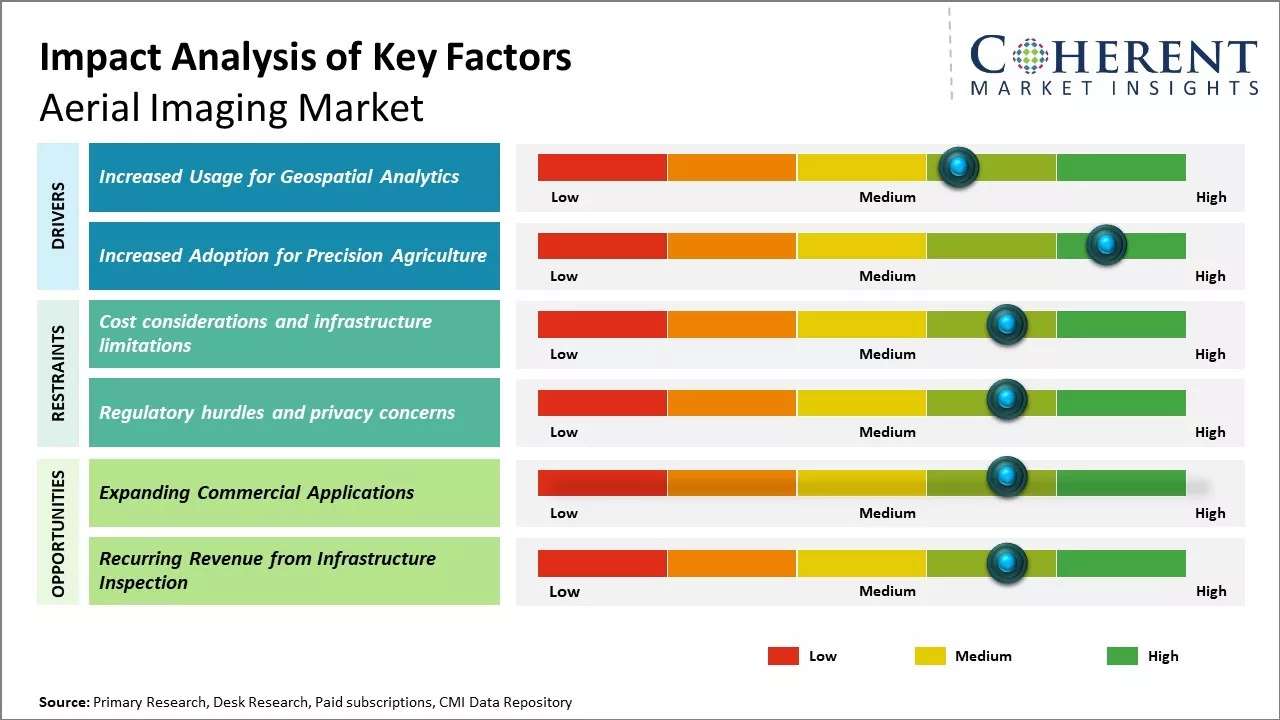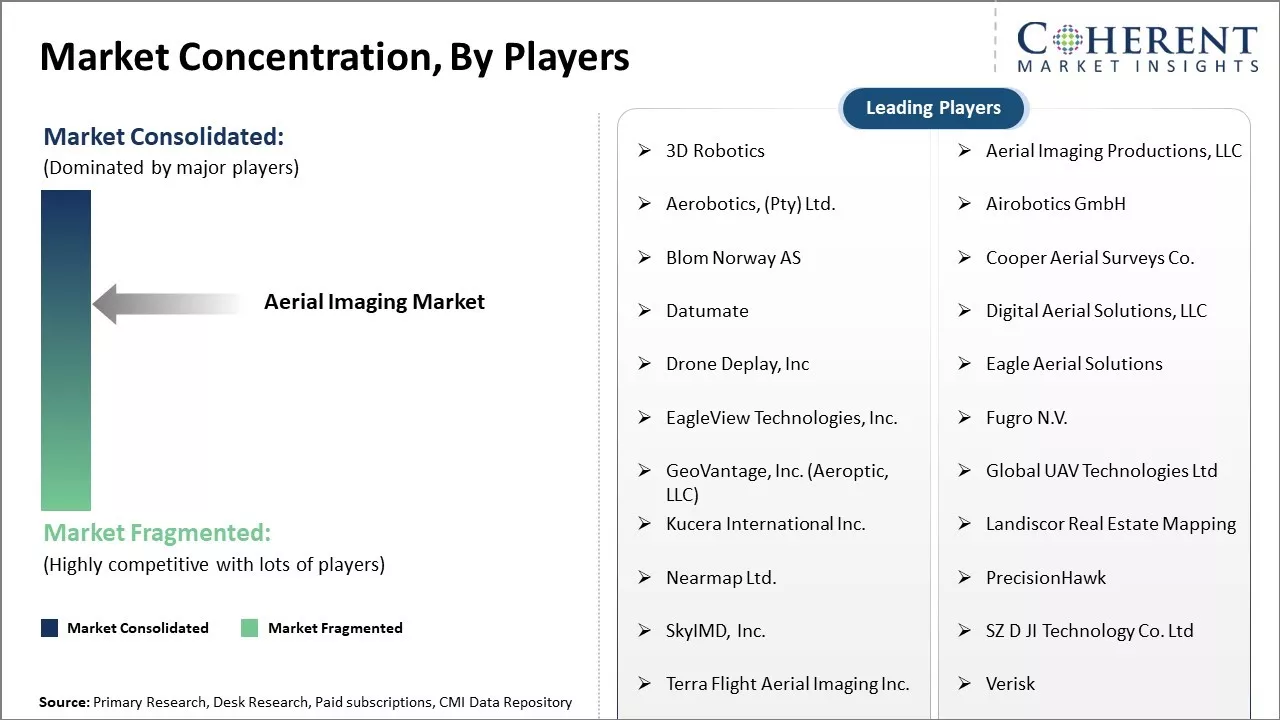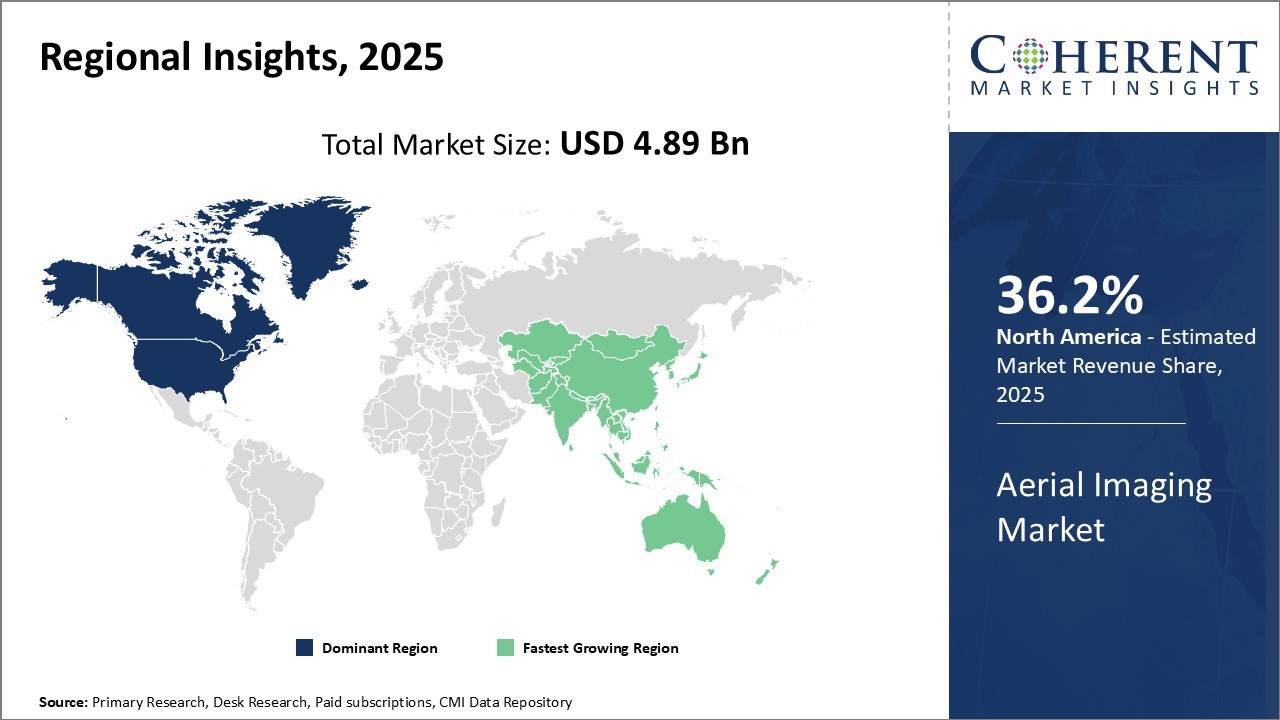The aerial imaging market size is estimated to be valued at USD 4.89 Bn in 2025 and is expected to reach USD 14.59 Bn by 2032, growing at a compound annual growth rate (CAGR) of 16.9% from 2025 to 2032.

To learn more about this report, Download Free Sample
The Aerial Imaging Market is likely to grow significantly throughout the forecast period. Key drivers that aerial imaging market growth includes the adoption of drones aerial cameras across various industries and rising investment in geospatial project. Aerial imaging is gaining prominence in agriculture, construction, government, media and entertainment for their surveys, map making, and spatial analysis.
|
Event |
Description and Impact |
|
Russia-Ukraine Conflict and Global Defense Spending |
|
|
China's Regulatory Crackdown on Civilian Drone Technology |
|
|
AI and Machine Learning Integration in Aerial Analytics |
|
Uncover macros and micros vetted on 75+ parameters: Get instant access to report
The aerial imaging market is experiencing a revolutionary transformation as artificial intelligence reshapes how organizations capture, process, and analyze visual data from above. From agriculture to urban planning, AI-powered aerial imaging solutions are delivering unprecedented accuracy and efficiency across multiple sectors.
For instance, in March 2025, FlytBase Inc., a leading drone autonomy software platform company, had announced the launch of AI-R (short for Aerial Intelligence for Robots), an advanced AI-powered framework designed to integrate AI into every aspect of docked drone operations.

To learn more about this report, Download Free Sample
The usage of aerial imagery for geospatial applications has significantly increased in recent years. With advances in sensor technology and data processing capabilities, high resolution aerial images can now provide valuable geospatial data and insights. Many industries such as agriculture, construction, infrastructure, and utilities are leveraging aerial imagery for various tasks such as land mapping, change detection, asset management, and site planning.
As aerial images captured over time can provide historical data about land usage and changes, they are extensively used for geospatial analytics. Geospatial companies are developing advanced analytics tools that use computer vision and machine learning models to extract location-based insights from aerial images at scale. Applications such as monitoring crop health, tracking urban development, assessing infrastructure projects, and planning utility networks are driving the demand for geospatial analytics.
Government agencies are also increasingly using aerial imagery driven geospatial analytics for city planning, disaster management, and environmental monitoring purposes. The ability to accurately analyze huge volumes of aerial images to gain spatial understanding of wide areas is boosting the aerial imaging market. Overall, the rising significance of geospatial insights is a major factor augmenting the aerial data collection and analytics capabilities worldwide.
Aerial imaging is witnessing significantly higher adoption in the agriculture industry for precision farming applications. Traditional agricultural practices involve treating entire farmlands uniformly without considering the varying needs of different sections. However, with the help of high resolution multispectral aerial images captured over agricultural fields, precise variability within fields can now be identified.
Powerful analytics on these aerial images helps farmers gain spatial insights about the differing health, nutrient and yield patterns across their farms. This enables more targeted application of inputs like water, fertilizers, and pesticides only where required. Industries are developing precision agriculture solutions and services that use aerial imagery, computer vision algorithms and decision support systems to provide field-specific prescriptions and recommendations to farmers.
The Aerial Imaging Market has high growth opportunities due to increasing commercial applications in industries like agriculture, insurance, construction, and real estate. More streamlined regulations can unlock its full potential. Infrastructure inspection provides recurring business.
Technological advances in drone hardware, cameras, data analytics, and 5G networks enhance capabilities. Collaboration between drone manufacturers, software firms, and end users may create new revenue models. Urbanization and monitoring of changing climatic conditions creates demand.
Geospatial Technology in expected to contribute the highest share of 23.0% in 2025, owing to its widespread use for various mapping and surveying applications Geospatial technology finds extensive use in mapping and surveying applications across various industries such as construction, transportation, utilities, and others. Rapid digitization and access to high resolution aerial and satellite imaging data have fuelled the adoption of geospatial technology solutions for mapping.
Government is expected to contribute the highest share of 25.93% in 2025, owing to the importance of aerial imaging for security and governance functions. Government organizations across defense, homeland security, urban planning, emergency response, and other areas are significant users of aerial imaging technologies.
Defense and intelligence agencies rely on aerial images from satellites, aircrafts, and Unmanned Aerial Vehicles for national security surveillance, tactical oversight of border areas, and monitoring potential threats. Aerial imagery helps gather real-time visual intelligence about enemy locations, movements, and activities. Law enforcement agencies also leverage aerial platforms equipped with cameras for surveillance of high-risk areas, monitoring of rallies or detecting illegal activities from above.

To learn more about this report, Download Free Sample
North America is projected to remain the dominant force in the global aerial imaging market, with a leading market share of 36.2% in 2025. The region is home to some of the industry’s largest and most experienced providers. These companies serve a wide range of end-user sectors such as agriculture, insurance, real estate, and infrastructure development.
Furthermore, the defense and homeland security sectors have long been primary adopters of aerial imaging solutions, driven by substantial government investments in surveillance and reconnaissance programs across the United States and Canada. This focus has fostered advanced capabilities in high-resolution imaging, mapping, and integrated software analytics.
North America also leads in the integration of emerging technologies such as artificial intelligence (AI), machine learning, and geospatial analytics for real-time aerial data interpretation. A mature regulatory environment and strong R&D ecosystem continue to support innovation and sustained market demand.
Asia Pacific is emerging as the fastest-growing regional market for aerial imaging, with an anticipated compound annual growth rate (CAGR) of 18.88% in 2025. Rapid urbanization, infrastructure expansion, and increasing adoption of smart city initiatives across countries such as China, India, and Indonesia are key drivers of regional demand.
Governments and private developers are deploying aerial imaging to monitor construction progress, assess land use, and enhance quality control across large-scale projects such as airports, railways, and road networks. The region also benefits from more flexible drone regulations compared to North America and Europe, accelerating the adoption of UAV-based imaging across commercial and agricultural applications.
The United States is the largest contributor to North America’s aerial imaging market. Its leadership is bolstered by a strong defense sector, substantial government contracts, and widespread commercial adoption across industries. Major players headquartered in the U.S. invest heavily in R&D, developing next-generation imaging systems powered by AI and cloud-based analytics. Additionally, robust infrastructure development and smart city initiatives further stimulate demand for aerial data solutions.
Canada plays a key role in the regional market with significant adoption in natural resource management, infrastructure development, and environmental monitoring. Government-backed initiatives for land mapping, forest surveillance, and disaster management have accelerated the use of drone and aircraft-based imaging. Canada’s collaborative ecosystem involving tech startups, government agencies, and academic institutions supports innovation in geospatial intelligence and imagery analytics.
China is a major growth engine within Asia Pacific’s aerial imaging market, fueled by its large-scale infrastructure development and emphasis on smart cities. Government-led projects require continuous aerial data capture for planning, monitoring, and quality assurance. The country is also a global leader in drone manufacturing, which facilitates the widespread deployment of low-cost imaging platforms across sectors such as construction, mining, and urban planning.
India is experiencing rapid growth in aerial imaging adoption, driven by nationwide infrastructure initiatives like Bharatmala and smart city missions. The agricultural sector is increasingly turning to precision farming, leveraging aerial imaging for crop monitoring and yield optimization. Government policies supporting digital land surveys and disaster preparedness further expand the addressable market. With a large pool of local integrators and drone operators, India is becoming a focal point for regional partnerships and market entry.
| Report Coverage | Details | ||
|---|---|---|---|
| Base Year: | 2024 | Market Size in 2025: | USD 4.89 Bn |
| Historical Data for: | 2020 To 2024 | Forecast Period: | 2025 To 2032 |
| Forecast Period 2025 to 2032 CAGR: | 16.9% | 2032 Value Projection: | USD 14.59 Bn |
| Geographies covered: |
|
||
| Segments covered: |
|
||
| Companies covered: |
3D Robotics, Aerial Imaging Productions, LLC, Aerobotics, (Pty) Ltd., Airobotics GmbH, Blom Norway AS, Cooper Aerial Surveys Co., Datumate, Digital Aerial Solutions, LLC, Drone Deplay, Inc, Eagle Aerial Solutions, EagleView Technologies, Inc., Fugro N.V., GeoVantage, Inc. (Aeroptic, LLC), Global UAV Technologies Ltd, Kucera International Inc., Landiscor Real Estate Mapping, Nearmap Ltd., PrecisionHawk , SkyIMD, Inc., SZ D JI Technology Co. Ltd , Terra Flight Aerial Imaging Inc., and Verisk |
||
| Growth Drivers: |
|
||
| Restraints & Challenges: |
|
||
Uncover macros and micros vetted on 75+ parameters: Get instant access to report
*Definition: The aerial imaging market involves companies that provide aerial or drone-based imaging services for various industries. These companies capture high-quality aerial photographs and videos from cameras mounted on aircrafts, helicopters, balloons, or drones. They offer aerial imaging services for industries such as agriculture, insurance, urban planning, public safety, infrastructure inspection, media and entertainment. Customers can use aerial images and analytics for applications like crop health monitoring, damage assessment, construction progress tracking, mapping and 3D modeling, advertising, and filmmaking.
Share
Share
About Author
Monica Shevgan has 9+ years of experience in market research and business consulting driving client-centric product delivery of the Information and Communication Technology (ICT) team, enhancing client experiences, and shaping business strategy for optimal outcomes. Passionate about client success.
Missing comfort of reading report in your local language? Find your preferred language :
Transform your Strategy with Exclusive Trending Reports :
Frequently Asked Questions
Joining thousands of companies around the world committed to making the Excellent Business Solutions.
View All Our Clients